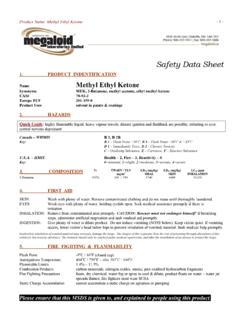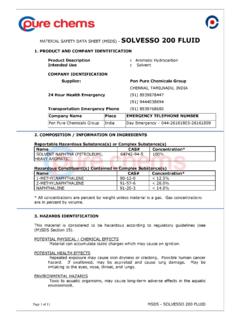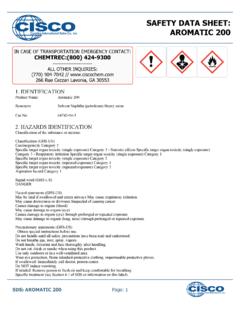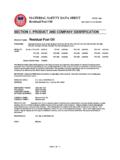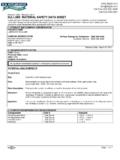Transcription of Safety Data Sheet - Megaloid
1 Product Name: aromatic 200 Please ensure that this MSDS is given to, and explained to people using this product. 1 Safety data Sheet 1. PRODUCT INDENTIFICATION Name aromatic 200 Synonyms heavy aromatic solvent naphtha CAS# 64742 94 5 Europe EC# 265 298 5 Product Uses diluent, solvent, fuel 2. HAZARDS Quick Guide: combustible liquid, heavy vapour travels, distant ignition and flashback are possible Canada WHMIS not controlled under WHMIS Key: B 2 Flash Point <38 o C, B 3 Flash Point >38 o C & <93 o C D 1 Immediately Toxic, D 2 Chronic Toxicity C Oxidising Substance, E Corrosive, F Reactive Substance HMIS Health 1, Fire 2, Reactivity 0 Key: 0=minimal, 1=slight, 2=moderate, 3=serious, 4=severe 3. COMPOSITION % TWAEV / TLV mg/m 3 LD50 (mg/kg) ORAL LD50 (mg/kg) SKIN LC50 ppm/mg/m s INHALATION Heavy aromatic Naphtha 100% 15 / 100* 7050 3160 / 590 *Manufacturer s recommendation.
2 aromatic 200 may also contain naphthalene 91 20 3 recommended regulated limit: 10ppm / 52mg/m 3 . 4. FIRST AID SKIN: Wash with soap &plenty of water. Remove contaminated clothing and do not reuse until thoroughly laundered. EYES: Wash eyes with plenty of water, holding eyelids open. Seek medical assistance promptly if there is irritation. INHALATION: Remove from contaminated area promptly. CAUTION: Rescuer must not endanger himself! If breathing stops, administer artificial respiration and seek medical aid promptly. INGESTION: Give plenty of water to dilute product. Do not induce vomiting (NOTE below). Keep victim quiet. If vomiting occurs, lower victim s head below hips to prevent inhalation of vomited material. Seek medical help promptly. Inadvertent inhalation of vomited material may seriously damage the lungs.
3 The danger of this is greater than the risk of poisoning through absorption of this relatively low toxicitysubstance. The stomach should only be emptied under medical supervision, and after the installation of an airway to protect the lungs. 5. FIRE FIGHTING & FLAMMABILITY Flash Point 95 o C / 203 o F (Pensky Martens closed cup) Autoignition Temperature 491 o C / 916 o F Flammable Limits Combustion Products carbon monoxide, nitrogen oxides, smoke, part oxidised hydrocarbon fragments FireFighting Precautions foam, dry chemical, water fog or spray to cool & dilute, water jet may spread flames Firefighters must wear SCBA Static Charge Accumulation accumulates a static charge on agitation or pumping: high flash point makes ignition unlikelyProduct Name: aromatic 200 Please ensure that this MSDS is given to, and explained to people using this product.
4 2 6. ACCIDENTAL RELEASE MEASURES Leak Precaution dyke to control spillage and prevent environmental contamination Handling Spill ventilate contaminated area recover free liquid with suitable pumps absorb residue on an inert sorbent, sweep, shovel & store in closed containers for recycling or disposal 7. HANDLING & STORAGE Store in a cool, dry environment, away from sources of ignition, heat and oxidising agents. Despite a high flash point, the manufacturer recommends grounding or electrically bonding the source container, receiving container, & transfer when transferring contents. Avoid splashing bykeeping the product nozzle below the surface in the receiving container. Always ensure that containers, whether empty or full, are tightly sealed unless in use. Avoid breathing product vapour.
5 Use with adequate ventilation. Never cut, drill, weld or grind on or near this container. Avoid prolonged contact with skin and wash work clothes frequently. An eye bath and Safety shower must be available near the workplace. 8. EXPOSURE CONTROL & PERSONAL PROTECTION Ontario TWAEV not listed manufacturer recommends 15ppm / 100mg/m 3 ACGIH TLV not listed manufacturer recommends 15ppm / 100mg/m 3 OSHA PEL 400ppm STEL not listed may contain less than 1% naphthalene CAS# 91 20 3: regulated limit 10ppm / 52mg/m 3 Ventilation mechanical ventilation may be required to control airborne titre depending on handling procedures Hands nitrile or Viton gloves recommended other types may also protect consult supplier to confirm suitability Eyes Safety glasses with side shields always protect the eyes Clothing wear impermeable (above) apron, boots, & long sleeves if there is any danger of splashing, 9.
6 PHYSICAL PROPERTIES Odour & Appearance clear, pale yellow liquid with mild aromatic (kerosene) hydrocarbon odour Odour Threshold not known Vapour Pressure / (20 o C / 68 o F) Evaporation Rate (Butyl Acetate = 1) below Vapour Density (air = 1) Boiling Range 232 275 o C / 450 527 o F Freezing Point 19 o C / 2 o F Specific Gravity ( o C) Water Solubility 1milligramsper litre (20 o C / 68 o F) Also soluble in most organic solvents Viscosity (25 o C / 77 o F) pH none (does not liberate hydrogen ions when dissolved) Conversion Factor 1ppm = 3 based on average molecular weight (below) Molecular Weight 160 grams per mole mixture, average value for product from one manufacturer 10. REACTIVITY Dangerously Reactive With strong oxidising agents Also Reactive With concentrated nitric or sulphuric acids Stability stable will not polymerize Decomposes in Presence of not known Decomposition Products none apart from Hazardous Combustion Products Sensitive to Mechanical Impact noProduct Name: aromatic 200 Please ensure that this MSDS is given to, and explained to people using this product.
7 3 11. TOXICITY Effects, Acute Exposure Skin Contact little to no effect Skin Absorption slight no toxic effects likely by this route Eye Contact may be slightly irritating may cause temporary blurred vision Inhalation headache, dizziness, drowsiness, intoxication, but only at very high vapour or mist titre Ingestion poorly absorbed may cause a (temporary) laxative effect Effects, Chronic Exposure General prolonged exposure may cause dermatitis may damage liver & kidneys Sensitising not a sensitiser in humans or animals Carcinogen/Tumorigen not considered a tumorigen or a carcinogen in humans or animals Reproductive Effect no known effect in humans or animals Mutagen no known effect on humans or animals Synergistic With not known LD50 (oral) 7050mg/kg (rat) for Solvesso 200, Exxon Antwerp LD50 (skin) 3160mg/kg (rabbit) for Solvesso 200, Exxon Antwerp LC50 (inhalation) 590mg/m 3 (rat) RTECS data 170mg/m 3 for Solvesso 200, Exxon Antwerp 12.
8 ECOLOGICAL INFORMATION Bioaccumulation may be a bioaccumulator Biodegradation degrades readily&rapidly in the presence of oxygen life near soil surface&30 60days in deeper layers 30 40% biodegradation in 28 days (in sewage sludge) Abiotic Degradation reacts with atmospheric hydroxyl radicals estimated life in air is days (for major constituent molecules of aromatic 200) Mobility in soil, water water insoluble moves slowly in soil and water Aquatic Toxicity LC50 (Fish, 96hr) 41 50mg/litre (Pimephelas promelas), 19mg/litre (Pimephelas promelas water soluble fractions only) (Oncorhynchus mykiss), 1740mg/litre (Lepomis macrochirus), 8000mg/litre (Tilapia mossambica) tests on various naphthas similar to aromatic 200 methods of emulsifying product into waterdiffer.. LC50 (Crustacea, 48hr) (Daphnia magna), 4720mg/litre (Dendronereides heteropoda), EC50 (Plankton, 96hr) 140mg/litre (Diatomus forbesi), 11,280mg/litre (Namalycastis indica) EC50 (Algae, 72hr) <1 & (Skeletonema costatum), 6mg/litre (Anabena doliolum) EC50 (Bacteria) no data NOTE: The variable results (above) may reflect the water insolubility of aromatic 200 &the difficulty of suspending it in water.
9 A large spill in protected waters may spread on the water surface, depriving animal life of oxygen. In open water, wave action should prevent this. 13. DISPOSAL Waste Disposal do not flush to sewer, recycle solvent if possible, may be incinerated in approved facility Containers Drums should be reused. Recondition and pressure test by a licensed reconditioner prior to re use. Pails must be vented and thoroughly dried prior to crushing and recycling. IBCs (intermediate bulk containers): polyethylene bottle must be pressure tested & recertified at 30 months. Replace at 60 months (5yrs). Steel containers must be inspected, pressure tested & recertified every 5 years. Never cut, drill, weld or grind on or near this container, even if emptyProduct Name: aromatic 200 Please ensure that this MSDS is given to, and explained to people using this product.
10 4 14. TRANSPORT CLASSIFICATION Canada TDG PIN UN not regulated for transport AND Shipping Name not regulated for transport 49 CFR Class & Packing Group not regulated for transport Marine Pollutant not a marine pollutant ERAP Required NO EMERGENCY INFORMATION Canada Call CANUTEC (collect) (613) 996 6666 Call CHEMTREC (800) 424 9300 15. REGULATIONS Canada DSL on inventory TSCA on inventory Europe EINECS on inventory Europe Classification Harmful Europe Risk Phrases R: 65 Harmful, may cause lung damage if swallowed. Europe Safety Phrases S: 23, 24, 62 Do not breathe fumes, vapour or spray. Avoid contact with skin. If swallowed, do not induce vomiting seek medical help immediately. 16. OTHER INFORMATION Prepared for Megaloid Laboratories by Peter Bursztyn, (705) 734 1577 data fromRTECS,HSDB(Haz.)
